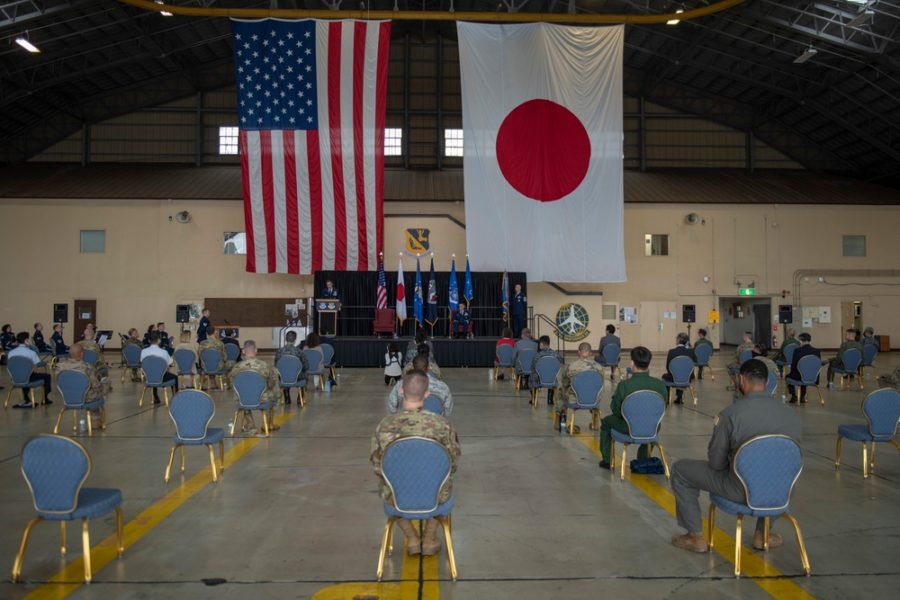The U.S. and Japanese air forces should look to strengthen their coordination and training, potentially even staging a high-level exercise in Japan, to counter the threats facing both countries in the Indo-Pacific region, U.S. Air Force Director of Staff Lt. Gen. Kevin B. Schneider said Nov. 5.
Speaking during a virtual forum hosted by the Stimson Center, Schneider emphasized the importance of interoperability and complementing capabilities between the U.S. Air Force and the Japan Air Self-Defense Force, also called Kōkū Jieitai.
Before he returned to the Pentagon this September, Schneider served as commander of U.S. Forces Japan and the Fifth Air Force, acting as the senior U.S. military representative to the island nation. In those roles, he said, one of his primary goals was “training and readiness now.”
“We’ve got to do more with what we have today. And while it’s great that we’re buying advanced systems, and looking forward into the future, we have to be ready today,” Schneider said.
Facing the triple threat of China, Russia, and North Korea all within striking distance, the JASDF and the U.S. Air Force should be training together more, Schneider said, suggesting Japan host a major exercise.
“Much of the training, much of the high-end training that we do between the U.S. Air Force and Kōkū Jieitai, takes place outside of Japan,” Schneider said. “So whether it’s Red Flag exercises we both participate in in Alaska, the fantastic Cope North exercises that take place down in Guam are great, but we have to go on the road to do that. Are there ways that we could do those types of high-end events in Japan? And I understand that that comes with a cost, and I understand local understanding and the sensitivities, but the challenges that are sitting on the front doorstep right now … ought to drive us to have those conversations.”
USAF and JASDF do regularly conduct some bilateral training exercises. The two services completed Exercise Southern Beach out of Kadena Air Base in Okinawa on Oct. 29, marking the first time a Japan-U.S. training program was conducted during nighttime hours.
But Schneider indicated that the air forces should collaborate on both large-scale exercises and smaller ones related to USAF’s Agile Combat Employment model, which is focused on quickly dispersing smaller contingents of multi-capable Airmen to remote bases. By doing so, he said, the American and Japanese forces can “build that connective tissue, exercise that muscle memory, put in place those systems so that when crisis or conflict happens, that we are not doing anything different. We’re just doing the same things that we do every day, but just at a higher volume.”
Gen. Shunji Izutsu, chief of staff for the JASDF, said his service is also working to implement the principles of ACE given the threats posed by nearby nations, though he noted that there are a number of difficulties in implementing that theory in real-world scenarios.
In addition to strengthening bilateral command and control systems, Schneider added that the U.S. and Japan should look to strengthen their ties in the acquisition realm as well. Buying the same system, like the two countries have done with the F-35, increases interoperability. But Schneider also suggested there could be value in coordinated but separate approaches.
“Looking at our long-range plan, does it make sense for us to buy the same stuff, or are there things that the United States can buy that has a certain capability, and Japan can buy complementary systems that have a different capability, but together, we’re able to cover the range of options and capabilities that we would need in conflict or crisis?” Schneider said.
Schneider’s push for even stronger ties between Japan and the U.S. come at a key moment in the Indo-Pacific. The Pentagon has increasingly emphasized China as America’s pacing threat in the world, and the Chinese recently conducted a joint naval exercise with Russia in which the two nations sent ships in a near circle around Japan’s main island.
As tensions rise, dialogue between the U.S. military and the People’s Liberation Army has deteriorated, Schneider said—in years past, USAF and the PLA Air Force would meet twice a year, “sit down in a room together, face to face, and go, ‘This happened on such and such a date. We felt this encounter was unsafe or unprofessional. What are you going to do about it,’ and vice versa.”
Those interactions weren’t always “completely satisfactory,” Schneider added, but they did have some effects and were generally helpful in ensuring incidents didn’t turn into full-blown conflict. Recently, however, the meetings have “dried up a little bit, … and that should cause us a little bit of concern,” said Schneider.

